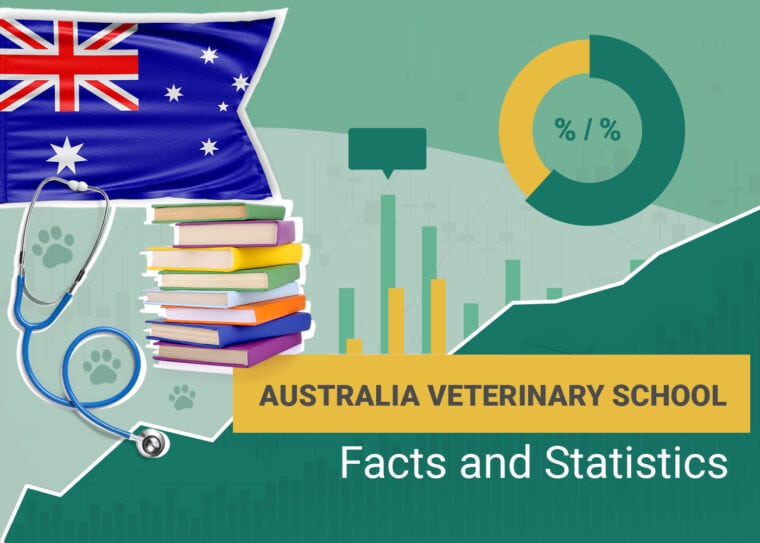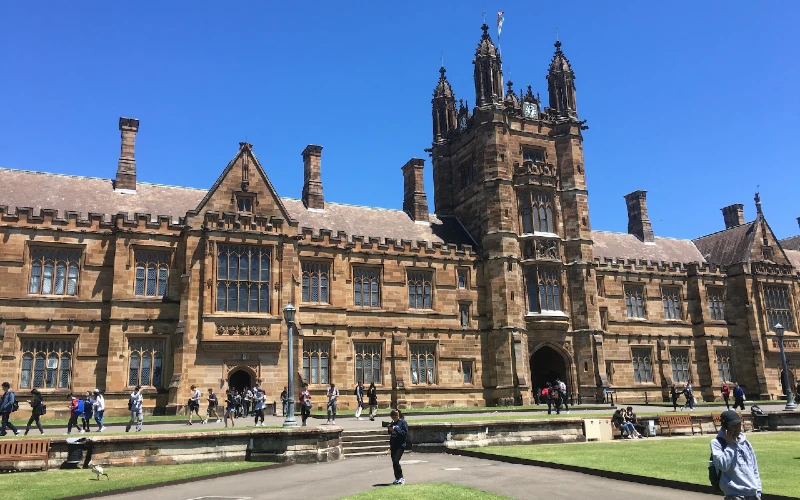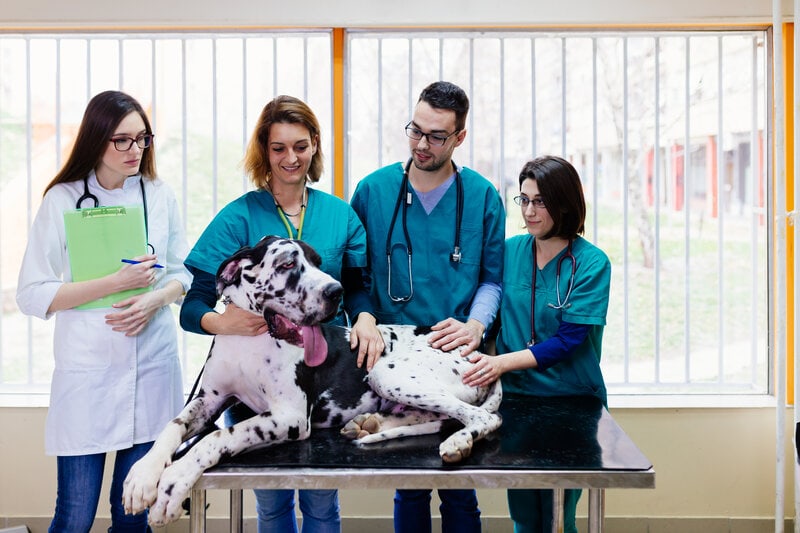
Click to Skip Ahead
Note: This article’s statistics come from third-party sources and do not represent the opinions of this website.
So, you want to become a veterinarian. Now what? Practicing veterinary medicine is one of the most rewarding careers. Helping sick animals, improving the food chain, and improving the well-being of humans all sound like proactive life goals—and they are! But it takes some time to get there. On average, it takes 5 to 7 years to complete veterinary school in Australia.
In this post, we’re breaking down 10 veterinary school statistics in Australia to help you decide if veterinary medicine is right for you.

Top 10 Veterinary School Statistics in Australia
- It takes 5 to 7 years to finish veterinary school in Australia.
- Australia has seven universities offering DVM degrees
- The lowest ATAR acceptance score is 98.05.
- Four veterinary universities in Australia offer online courses.
- The average yearly cost of veterinary school for full-fee students is between $50k to $60k AUS.
- The average yearly cost for commonwealth schools is AUD 10,000.
- Each veterinary school produces 500 to 550 graduates per year.
- In a 2021 survey, 67.3% of graduating veterinarians were female.
- Less than 20% of veterinarians pursue higher education past a bachelor’s degree.
- In a 2021 survey, 24% of graduating veterinarians received their degrees from Sydney University.


Getting Accepted Into Vet School
1. It takes 5 to 7 years to finish veterinary school in Australia.
(VSANZ)
Depending on the school you choose, and whether or not you attend part-time or full-time, it will take about 5 to 7 years to finish your degree. Most veterinary programs require students to attend full-time, though.
You’ll need to obtain a bachelor’s degree, which takes about 3 to 4 years. Next is your Doctor of Veterinary Medicine (DVM) degree, which takes about 3 to 4 years, depending on the school.

2. Australia has seven universities offering DVM degrees.
(VSANZ)
Thanks to the growing demand for veterinarians, your university options in Australia are higher than ever. Australia now has seven universities offering DVM degrees, compared to the five they had previously.
This means you won’t have to wait as long to reapply if you’re not accepted into your chosen university. Or you can apply to a different school. In Australia, your choices are:
Each school has different pricing and entry requirements, so do your research on each.
3. The lowest ATAR acceptance score is 98.05.
(University of Sydney)
If you’re going straight to vet school out of high school, you’ll need to take the ATAR and have an impressive score of 98. Keep in mind, each school has different requirements. Highly competitive schools like the University of Sydney will want a 98 for a median ATAR.
Their ATAR alone won’t get them into a veterinary program for most people. But if you’re aiming to jump feet first into a DVM after high school, a 98.05 is what you’ll need- at least.


Attending Vet School
4. Four veterinary universities in Australia offer online courses.
(University of England)
If you’re worried about time restraints while you study, don’t worry. You can study for a DVM online if you have a tight schedule. Of course, certain classes need to be completed in person. But for the most part, veterinary school is much more convenient, thanks to the internet.
Four schools, in particular, offer online classes for a DVM. These include:
5. The average yearly cost of veterinary school for full-fee students is between AUD 50K to 60K.
(Vet Choice)
University is expensive, and unfortunately, the prices keep climbing. The average cost is about AUD 50K to 60K and will reach up to $70K per year for highly-competitive schools. Veterinary school is one of the most costly majors, so full-fee students should expect to pay a hefty yearly price tag.
Price can affect how long you attend school in a few ways. You may spend more time working to cover the cost of schooling than studying. If you’re working to pay for school, that can significantly affect how well you do in your classes.

6. The average yearly cost for commonwealth schools is AUD 10,000.
(Vet Choice)
Luckily, commonwealth-supported universities make receiving a DVM more accessible. A commonwealth-supported university is where the government pays a portion of your school fees. You should expect to pay at least 10,000 AUD per year to earn a DVM at a commonwealth university.

Graduating Vet School
7. Each veterinary school produces 500 to 550 graduates per year.
(Vet Practice Mag)
In the past 10 years, the number of veterinary schools has increased from five to seven, leading to more veterinary graduates. Each of the seven veterinary schools produces about 500 to 550 graduates annually.
Despite this, Australia is still desperate for veterinarians, especially in rural communities.

8. In a 2021 survey, 67.3% of graduating veterinarians were female.
(2021 Australian Veterinary Workforce Survey)
When you graduate from veterinary school, expect most of your classmates to be females. A survey from 2021 found that, out of 3,749 respondents, 67.3% of graduating veterinarians were female.
This fact doesn’t affect your time in veterinary school. Still, it does show that the veterinary field is now female-dominant compared to the past decades.
9. Less than 20% of veterinarians pursue higher education past a bachelor’s degree.
(Labour Market Insights)
After receiving a bachelor’s degree and DVM, less than 20% of veterinarians return to school for higher education. This isn’t to be confused with continuing education. All veterinary professionals must take courses to keep their medical knowledge fresh. But many veterinarians don’t return to university.

10. In a 2021 survey, 24% of graduating veterinarians received their degrees from Sydney University.
(2021 Australian Veterinary Workforce Survey)
In 2021, the Australian Veterinary Workforce Survey found that, out of 3,770 respondents, 24% of veterinarians had graduated from Sydney University. About 22% graduated from Queensland University, and 19% graduated from the University of Melbourne.
Only 13% of graduates attended Murdoch University. Adelaide, Charles Sturt, and James Cook Universities had the lowest alum scores of 4% for each school.

Frequently Asked Questions About Veterinary Schools in Australia
What is the best vet school in Australia?
As of 2022, the University of Sydney is the top veterinary school in Australia. The University of Melbourne and The University of Queensland are second and third.
What subjects are needed to become a vet in Australia?
Each university has different pre-requisite requirements for earning a DVM. However, each school requires courses in biology, chemistry, and physics. It’s best to take as many classes as possible in these subjects.

What is the oldest veterinary school in Australia?
The University of Melbourne started the first veterinary program in Australia in 1886. Since then, it’s become one of the top-performing veterinary schools in the country.
Are veterinarians paid well in Australia?
Generally, the average salary of a veterinarian in Australia is $116,000 annually. A veterinarian’s salary varies considerably based on location, experience, and hours worked. It also depends on if the doctor works in general practice, emergency, or specialty care.

Conclusion
So, what’s next? Study, study, study. Becoming a veterinarian is no easy feat. It takes several years of demanding work. And let’s face it, a lot of money too.
Even though the degree takes a few years to complete, you’ll have plenty of time to decide what area of veterinary medicine you want to pursue. Focus on your studies, and let your future happen naturally. You’ll be changing the lives of animals and humans in no time.





